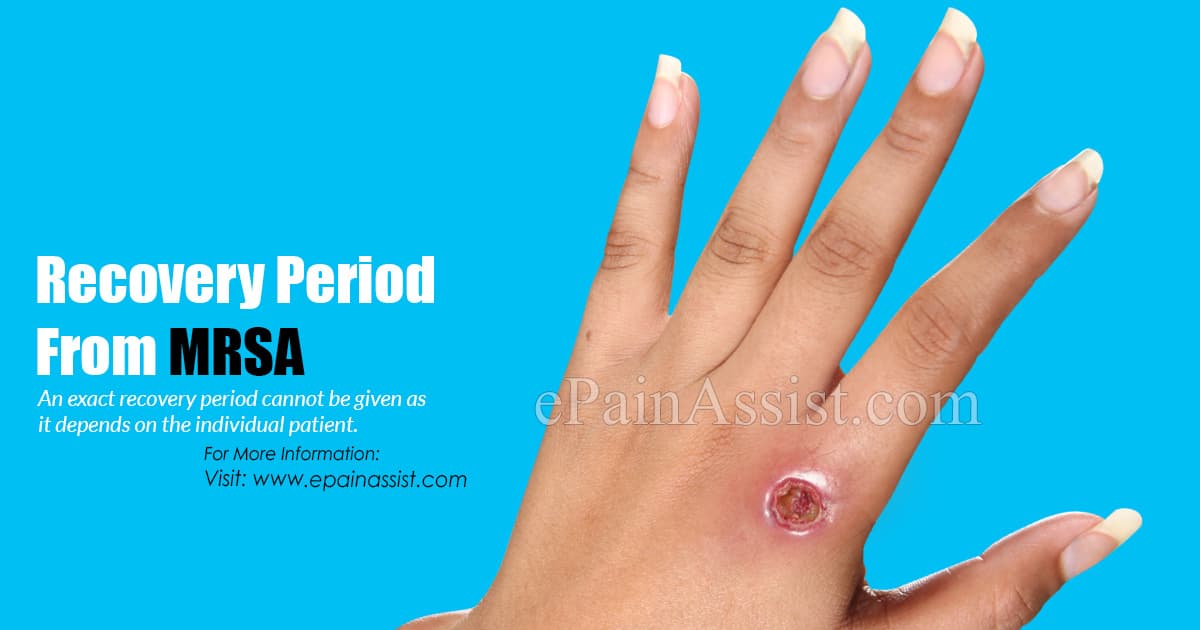Methicillin-resistant Staphylococcus aureus (MRSA) is a huge burden on the healthcare sector currently. In the United States, less than 2% of the population carries MRSA colonies. The infection can be divided into hospital-associated MRSA (HA-MRSA) and community-associated MRSA (CA-MRSA). In 1974 the HA-MRSA patients in intensive care units were 2% and it was 64% in 2004, the numbers have increased rapidly. It is estimated that there about 126,000 MRSA admission each year in the U.S. most of the skin and soft-tissue infections are caused by MRSA and each year about 94,000 patients are infected with MRSA and there are about 19,000 deaths each year. Most of these infections are due to HA-MRSA (86%) and only a small percentage due to CA-MRSA (14%).

Recovery Period From MRSA
An exact recovery period cannot be given as it depends on the individual patient. The severity of the infection, response to the antibiotics, and the site of infection all contribute to the recovery period. If you are not having a serious infection you can be treated at home with oral antibiotics which you should continue for 7-10 days. The antibiotics should be taken exactly as prescribed without missing any dose, for the prescribed period of time. You should not stop the antibiotics once you feel better when the symptoms are resolving as this does not mean the infection is completely cured. It can still be in your body, also when you do not complete the antibiotic course for the required period of time antibiotic resistant can develop which can cause a recurrent infection of MRSA with a more resistant bacterium.
If your infection is severe and if it involves a major organ then you need to be treated in a hospital with intravenous antibiotics. The intravenous antibiotics are continued until your condition improves. Then oral antibiotics of the same antibiotics are given for another few days or even for weeks depending on the complications and source of infection e.g. septic arthritis, endocarditis needs prolong antibiotic treatment.
Many people get cured when the symptoms of MRSA infection are resolved. However, 2 out of 100 people may carry the MRSA as transient or colonizing organisms in parts of the body such as in the nose without symptoms. These patients can be cured with topical antibiotics sometimes.
Treatment Of MRSA
The antibiotics are the mainstream of treatment for MRSA. A blood culture or body fluid culture of the affected organ should be done to confirm the presence of MRSA infection and in order to determine what the sensitive and resistance antibiotics for the MRSA infection are. However, this might take few days (2-3) and until such time patients are treated empirically with antibiotics which give a broad-spectrum coverage and if the clinical features are more suggestive of MRSA then antibiotics that are usually sensitive to MRSA infection are given.
Usually, two or more antibiotics are used to treat an MRSA infection. The usual antibiotics that are sensitive to MRSA infection are:
- Linezolid
- Daptomycin
- Quinupristin
- Vancomycin
- Clindamycin
- Trimethoprim-sulfamethoxazole
- Tygacil
Additional surgical intervention might be needed according to the site of infection.
Conclusion
Methicillin-resistant Staphylococcus aureus (MRSA) is a huge burden on the healthcare sector currently. An exact recovery period cannot be given as it depends on the individual patient. The severity of the infection, response to the antibiotics, and the site of infection all contribute to the recovery period. If you are not having a serious infection you can be treated at home with oral antibiotics which you should continue for 7-10 days. You should not stop the antibiotics once you feel better when the symptoms are resolving as this does not mean the infection is completely cured. If your infection is severe and if it involves a major organ then you need to be treated in a hospital with intravenous antibiotics. The intravenous antibiotics are continued until the patient is improving. Then oral antibiotics of the same antibiotics are given for another few days or even for weeks depending on the complications and source of infection.
- Centers for Disease Control and Prevention (CDC) – MRSA in Healthcare Settings: https://www.cdc.gov/mrsa/healthcare/index.html
- Mayo Clinic – MRSA Infections: https://www.mayoclinic.org/diseases-conditions/mrsa/symptoms-causes/syc-20375336
Also Read:
